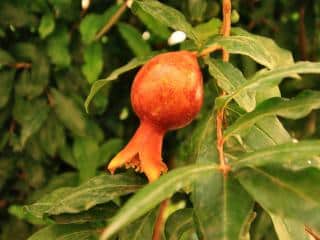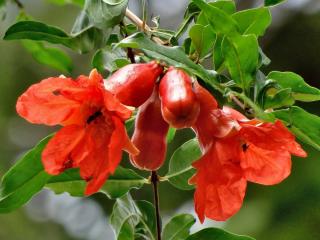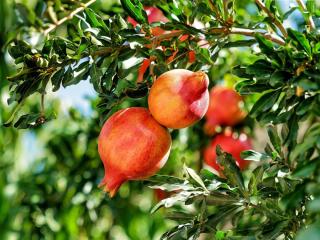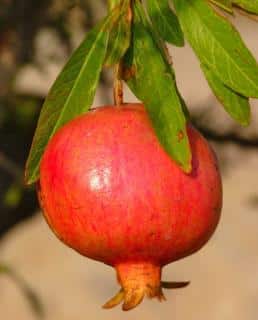

Pomegranate is a real eye-catcher when it comes to bloom – generous and bright. Its famed fruit, the pomegranate, however, likes to play hard-to-get unless you’re in regions with a specific climate.
Pomegranate tree key facts:
Latin name: Punica granatum
Family: Punicaceae, Lythraceae
Type: bushy tree
Foliage: deciduous
Height: around 13 ft (around 4m)
Exposure: sunny, sheltered from wind
Soil: prefers limestone, good drainage, cool depth-wise
Hardiness: not too cold (down to 32°F/0°C) – Bloom: summer – Harvest: fall
Growing a pomegranate bush? It’s child’s play! This bush doesn’t fuss about soil types. As long as your soil drains well and remains cool at depth, it’s a happy camper. A little lime in your soil? Even better for your pomegranate! For location, choose a warm, sunny spot sheltered from wind – ideally, a south-facing wall nearby.
Spring is the top season to plant your pomegranate bush, especially if your winters get pretty cold.
Found the perfect spot for your bush? Here’s your next steps:
 Dig a wide, deep hole.
Dig a wide, deep hole.Want to plant a potted pomegranate? Here’s how:
Smart tip:
Keep soil moist by adding a thick layer of natural mulch at pomegranate’s base. But steer clear of pine bark. It can make your soil too acidic.

Watch out for watering during dry spells, especially for potted plants.
For potted varieties, plan for repotting every 4 to 5 years. In the meantime, add a bit of potting soil to the base of your pomegranate (topdressing).

Want more pomegranate plants? Use cuttings of semi-woody stems at summer’s end. Protect your cuttings from winter cold and replant them the following spring.
Despite low frost-hardiness, a pomegranate is a vigorous shrub. It stands strong against diseases, pests, or parasites.

You’ll want to pick these goodies just before peak maturity, as soon as they show off a deep orange-red color.
Wait too long and—pop! They split open.
Keeping is also easy: you’ve got 2 weeks at room temp, or stash them in the fridge for months.
When your Punica granatum reaches up to 13 feet (4 meters) in width, somewhat between a small tree or a large shrub.
Its deciduous, shiny, oblong leaves change colors, switching from a lovely bronze in spring to a tender green later. Then come flowers, the pomegranate’s crowning glory. Boasting a vivid red, they pop out in summer, about 1 to 1.5 inches (3 to 4 cm) in diameter, they’re funnels of wrinkled petals.
Fall may bring about spherical fruit with a red-brown hue, reaching a size of around 4 inches (about 10 cm) in diameter. They’re healthy with lots of vitamins. Realistically, you’ll only see these under certain conditions, like in a warm coastal climate. Anywhere else, and it’s a struggle for them to ripen.